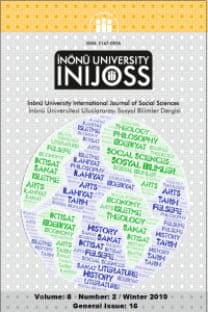REGIONAL HEALTH CARE INEQUALITY IN TURKEY: SPATİAL EXPLORATORY ANALYSIS
LISA cluster, Moran’s I statistic, Regional health care inequality, Theil index.
___
Akita, T, “Decomposing regional income inequality in China and Indonesia using two-stage nested Theil decomposition method”, The Annals of Regional Science, Vol.37, (2003), pp.55–77. Anselin, L. “Local Indicatiors of Spatial Association – LISA”, http://www.drs.wisc.edu/documents/articles/curtis/cesoc97712/W4_Anselin1995.pdf , 23.05.2008. Anselin, L. “Spatıal Data Analysıs With GIS: An Introduction To Application in The Social Sciences”, http://www.ncgia.ucsb.edu/Publications/Tech_Reports/92/92-10.PDF, 10.02.2009. Blohm, M. and Ohlsson, I., “Experience in measurement of welfare components and their regional implications”, Review of Income and Wealth, Vol.19, (1973), pp.167–188. Chakravarty S. (1996), “A measurement of spatial disparity: The case of income inequality”, Urban Studies, Vol. 33, No: 9, (1996), pp.1671–1686. Cliff, A. and Ord J.K., Spatial. Processes, Models and Applications, London: Pion, (1981). Fang ,P., Dong, S., Xiao, J., Liu, C., Feng, X. and Wang, Y. “Regional inequality in health and its determinants: Evidence from China”, Health Policy, Vol.94,(2010), pp.14–25. Fedorov L. “Regional inequality and regional polarization in Russia, 1990– 99”,World Development, Vol.30, No:3,(2002), pp.443–456. Kawachi I., Subramanian S.V. and Almeida-Filho N. “A glossary for health inequalities”, Journal of Epidemiology and Community Health, Vol.56, (2002), pp.647–52. Merzel, C. “Gender differences in health care access indicators in an urban, low-income community,” American Journal of Public Health, Vol.90, No.6, (2000), pp. 909-916 Moran T. P. “On the theoretical and methodological context of cross-national inequality data”, International Sociology, Vol.18, No.2, (2003), pp.351-378. Preston, Samuel H. “The changing relation between mortality and level of economic development”, Population Studies, Vol.29, No.2, (1975), pp.231– 248. Ravallion M. Growth , “Inequality and Poverty: Looking Beyond Averages”, http://siteresources.worldbank.org/INTPGI/Resources/13996_MR2.pdf, 10.06.2010 GÜLER A. ve KAPLAN D., “Türkiye İçin Erken Uyarı Endeksi Öneriler”, VII. Ulusal Ekonometri ve İstatistik Sempozyumu, 26-27 Mayıs (2005), s.1-18 Quadrado, Lucia, Folmer, Henk and Loman, Sudha, “Regional Inequality in the Provision of Health Care in Spain”, Environment and Planning A, Vol.33, No.5, (2001), pp.783–798. Walters, Sarah and Suhrcke, Marc, “Socioeconomic inequalities in health and health care Access in central and eastern Europe and the US: A review of the recent literature”, http://www.euro.who.int/__data/assets/pdf_file/0006/125457/e94412.pdf, 13.05.2011.- ISSN: 2147-0936
- Yayın Aralığı: Yılda 2 Sayı
- Yayıncı: İnönü Üniversitesi
BORÇ VE YAPISAL KIRILMALAR: 1990- 2011 TÜRKİYE ÖRNEĞİ
Ali KOÇYİĞİT, Tayfur BAYAT, Mustafa Ercan KILIÇ
Yusuf KARAKILÇIK, Levent GÖKDEMİR
Bilimsel Araştırmalarda Yapısal Etmenler ve Evreler
REGIONAL HEALTH CARE INEQUALITY IN TURKEY: SPATİAL EXPLORATORY ANALYSIS
Fatma ZEREN, Ayşe ARI, Emin Yahya MENTEŞE
AD-AS MODELİNİN YAPISALCI VAR YAKLAŞIMIYLA İNCELENMESİ: TÜRKİYE ÖRNEĞİ
Yusuf Ekrem AKBAŞ, Mehmet ŞENTÜRK
